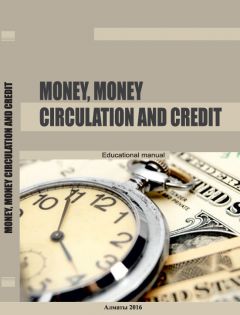Текст книги "Money, money circulation and credit"

Автор книги: Коллектив авторов
Жанр: Учебная литература, Детские книги
сообщить о неприемлемом содержимом
Текущая страница: 3 (всего у книги 16 страниц) [доступный отрывок для чтения: 4 страниц]
Credit money is a collective term appeared on the basis of the private individuals’ or government’s real obligations substitution. It occurred due to the money function as a mean of payment where money acts as an obligation which should be redeemed by a real money according to a due date. Credit money includes bills, banknotes, cheque, electronic money.
Banknote is a perpetual debenture guaranteed by the Central Bank of the State. Initially the banknotes had a gold guarantee of exchange onto the gold. They are issued with a strictly defined denomination and in principle are concerned as a national money on all the State territory.
Till 1990 in the Soviet Union circulated as the treasury notes so the USSR banknotes. The first included the monetary units with small denominations of 1, 3 and 5 rubles issued by the Treasury and marked as the «treasury notes». The notes with nominations more than 10 rubles were issued by the USSR State Bank, i.e. were the banknotes.
Nowadays the monetary units in Kazakhstan are issued only by the National Bank of the Republic of Kazakhstan (under the RK law dated from March 30, 1995 № 2155 «About the National Bank of the Republic of Kazakhstan»).
According to this law the banknotes and coins issue, their circulation organization and withdrawal from the circulation on the territory of Kazakhstan are performed only by the National Bank of RK exceptionally. The banknotes and coins emission to the circulation is performed by the National Bank by means of their sale to private and legal individuals.
There are also the following statutes and regulations in respect to the banknotes issue, circulation and withdrawal: the management decree of the National Bank of the Republic of Kazakhstan from December 12, 2005 № 163 «About the adoption of regulations of sale and purchase of national currency banknotes and coins by the National Bank of RK»; the management decree of NB RK from December 26, 2003 № 477 «About the adoption of regulations of the national currency of RK banknotes and coins fitness for use determination)).
Bill of credit. The bills and cheques are the earliest forms of non-cash money invented by bankers. The archeologists discovered the evidences of the fact that the prototypes of such monetary documents were used by merchants and bankers of the Ancient Babylon, i.e. 20 centuries B.C.
However the true story of bill is linked with the capitalistic relations development. Thus the country of a transfer bill’s origin is considered Italy where in the XII-XIIIth centuries in the most prevailing conditions of the economical, political and geographical factors the capitalism and trade ties with other countries developed. It is a necessity of trade turnover and market trade development that brought into the world the bill of credit.
The bill of credit is a debitor’s written absolute commitment to pay a definite sum when and where due. An absoluteness of the bill differences it fundamentally from an ordinary receipt where usually the reasons and terms of the future payment are denoted. But the bill doesn’t denote the factors according to which a person who draws out a bill (a bill drawer) is obliged to pay the denoted sum to the bill holder.
Moreover unlike the bill of debt the law allows the bill holder not to wait for maturity in order to use it as a mean of payment to a third person, i.e. as one of a money kind.
The standards harmonization of an international drawing right happened only in 1930 in Geneva where the uniform Bills of Exchange Act (BEA) was adopted. Enshrined in the BEA main features and types of the bills and the mechanism of their circulation are currently remain basic for the modern world bills of credit market.
In the USSR the bills were used in the domestic circulation till 1917, later from 1922 till 1930. From 1930 till 1990 the bills of credit were not used in the domestic circulation of the whole USSR territory. From 1991 the usage of bills became possible in Kazakhstan because of the first national law adoption «About the paper holdings circulation and stock-markets in the Kazakh SSR» № 650-XII where a bill of credit was classified as a paper holding.
On February 27, 1992 the National Bank management adopted a temporary provision about the bills of exchange accounting system in the Republic of Kazakhstan.
One of the important points in the bills circulation development in Kazakhstan became the adoption by the President of Kazakhstan Nursultan Nazarbayev in April 28, 1997 of the law «About the bills of exchange circulation in the Republic of Kazakhstan» where was mentioned that the bills circulation in the state includes the issue and circulation of the ordinary and transfer commercial bills. The banks are not obliged to issue their own bills, they just play the role of the discount houses. Either it is forbidden by legislation to issue the accommodation, tanned and financial bills of exchange.
According to the law «About the bills of exchange circulation in the Republic of Kazakhstan» a promissory bill (one name paper) is a bill which contains an unconditional obligation of a bill drawer to pay on demand at a certain term in future a denoted in the bill sum to the bill holder. And a bill of exchange (transfer note) is a bill which contains an unconditional offer (order) of the bill drawer (trassans) to his debitor (trassatus) to be payable to a third person (remittee) or to his order at a determinable future time or upon the denoted in the bill sum presentation.
The bill of exchange in itself has no force of a lawful currency that’s why in practice it is used that the debitor (trassatus) is obliged to record in writing his agreement to make payment according to the bill at maturity, i.e. to make a draft acceptance.
According to the article of the law 24 «About the bills of exchange circulation in the Republic of Kazakhstan» the acceptance is determined by the word «accepted» or the other synonymous word. A simple payer’s signature put on an obverse has a right of an acceptance.
Practically there are also:
– commercial bill which is based on the real purchase and sale deals on credit;
– banking bill issued by bank to its client in order to accumulate the funds;
– treasure bill issued by government in order to pay budget deficit and cover budgetary gap.
To the obvious advantages of both classic and modern bills could be related in particular a facilitated mean of the rights transmission accordingly by means of a special handover note on the bill’s reverse – endorsement. Under the Article 12 of the Law «About the circulation of bills in the Republic of Kazakhstan» the endorsement should be put on the bill itself only or on a special additional page – allonge (it is attached to the bill in case of the lack of space on it for the new handover notes).
There are several examples of the handover notes: «the order of» (a name of a new bill holder follows with the date and signature of an endorser) or «pay instead of me».
The bill’s credibility could be enforced by an aval – a guarantee of an exchange bill. A party which issued it – avalist (as a rule a bank) accepts responsibility for the bill’s commitments execution from a bill drawer’s (endorser’s) side. An aval could be drawn in a kind of a note on a bill or on an additional page (allonge).
Under the article 83 of the Law «About the circulation of bills in the Republic of Kazakhstan» dated from April 28, 1997 the discount houses (banks) can perform the following kinds of operations with the bills of exchange:
– the bills for collection acceptance;
– the bills discounting and avalization;
– the bills settlement by a payer services rendering and the domiciled bills settlement;
– the bills acceptance in the order of mediation.
All the above listed operations are executed by the commercial banks under a licence issued by the Committee for the control and supervision of financial market and financial organizations of the national bank of Republic of Kazakhstan.
The transition toward a market economy of Kazakhstan conditioned the return to an economic turnover of many financial instruments which were not in demand in the period of planned economy but are widely used in the modern economically developed countries. One of these instruments is a bill of exchange.
If compare the development of bank operations with the bills of exchange in the beginning of 90th of the last century and their today’s station it could be noted that nowadays the volume of these operations widely increased though it leaves much to be desired.
If in the beginning and middle of 90th of the XXth century the banks almost did not use the bills but in the end of 90th and the beginning of 2000th there were some activity in this sector of banking services. The most widespread bills’ operations today are discount, rediscount, avalizing of bills. The main reason of the bills of exchange market activation of the country was the development and implementation of the row of legislative acts concerning the bills of exchange turnover:
The second-tier banks rules for conducting of transactions with bills of exchange and promissory bills approved by a decision of the board of directors of the National Bank of the Republic of Kazakhstan dated from November 15, 1999 № 397.
The bills of exchange accounting rules of the second-tier banks of the Republic of Kazakhstan approved by a decision of the board of directors of the National Bank of the Republic of Kazakhstan dated from November 15, 1999 № 396.
The rules of rediscount of bills by the National Bank approved by a decision of the board of directors of the National Bank of the Republic of Kazakhstan dated from November 15, 1999 № 395.
The policy and procedure for rediscount of bills of the National Bank of Kazakhstan approved by a decision of the board of directors of the National Bank of the Republic of Kazakhstan dated from March 21, 2000 № 111.
The instruction on the financial analysis the bills’ emitters and the limits determination of the bills rediscount approved by a decision of the board of directors of the National Bank of the Republic of Kazakhstan dated from March 16, 2000 № 96.
The Law «About the cost of stamping in regard to the bills of exchange and promissory bills in the Republic of Kazakhstan)) dated from December 15, 2000 № 122-II (repealed).
Cheque is a due form financial document containing an ultimate order of an account owner in a loan institution about a payment to a cheque holder a definit sum of money. Initially the cheques appered in the XVI-XVII centyries in the Great Britain and Holland.
There are three different types of cheques: an order check which is untransferable issued to a person by name; a bearer cheque not indexed by name; an order cheque issued to a certain person but with the right of disposal by endorsement.
In Kazakhstan the cheques issue, circulation and payment is performed on the basis of the following normative legal documents: the Law of the Republic of Kazakhstan dated from July 29, 1998 № 237-I «About the payments and money transfers»; «The rules of cheques application on the territory of the Republic of Kazakhstan» dated from December 5, 1998 № 266; and the National Bank of the Republic of Kazakhstan board of directors decision dated from April 25, 2000 № 179 «About the regulations adoption of the financial instruments application, the wire transfers execution and remissions on the territory of the Republic of Kazakhstan».
According to these laws and regulations in Kazakhstan could be issued the following types of cheques:
A covered check supplied with a deposit preliminary placed by a cheque drawer to an account;
An uncovered cheque without sufficient funds. The cheques can contain a bank guarantee to their payment including according to the uncovered cheques.
A cheque drawing is a mean of payment which is performed by means of a payment document issue by a cheque drawer to a cheque holder. A cheque issue is not a monetary obligation fulfilment by a cheque drawer for which such cheque was drawn.
The fulfilment of such obligation happens in the moment of a cheque money receipt. The rights and obligations of a cheque drawer and bank in regard to a cheque application are based on an agreement about the cheques application between the cheque drawer and bank. The right of a cheque holder appears in the moment of a cheque receipt from a cheque drawer.
A cheque holder receives a right of a cash claim to the bank of a cheque drawer in amount indicated in cheque. The bank of a cheque drawer pays a cheque presented by a cheque holder or reasonably dishonors it in the terms prescribed by the laws and regulations of the National Bank of the Republic of Kazakhstan.
By means of electronic money, i.e. on the basis of paperless carriers in the form of electronic signals a vast majority of interbank transactions is exercised. The advanced technologies transition created the conditions for the paper cheques and cheque books change on the credit cards with the electronic microcircuits. The credit cards are widely used in the sphere of different trades and services.
The study about the electronic money as a type of credit money is necessary to carry over by a separate matter because this theme is quite new and wide thus requires the more detailed consideration.
1.2.4. Electronic moneyThe banking system computerization in the beginning of 60s of the last century gave an opportunity to begin the usage of plastic cards. Electronic money is the monetary units electronically kept on the facilities (plastic cards) which are at the disposal of owners.
The basic elements of the electronic money system are the automated clearing houses (ACH), the systems of automated cashiers (electronic booking offices and cash machines) and terminals set in the points of purchase. The electronic money emission is carried out by the bank which serves the plastic card owner. In one case the emission is provided by the monetary means which are kept on the owner’s account of the bank and the cost of a commodity immediately debits. And in the other the bank emits electronic money by client’s crediting and allows a plastic card holder to postpone payment of goods and services purchase.
Notwithstanding that plastic cards were widely used in the World beginning from 60s of the XXth century in Kazakhstan the market of plastic cards began to develop only in 1993 from the National interbank system of electronic cards foundation with the usage of microprocessing debit and credit cards on the basis of electronic wallets conception.
The realization of electronic wallet conception is not provided in its «pure» form, i.e. before the payments settlement but as follows money discounted on the clients’ microprocessing cards actually stays in bank on the clients’ current accounts consequently allowing accumulating it in the banking system. The population receives an opportunity to make payments for goods and services in any place of the Republic of Kazakhstan and regardless of what bank serves the card holder.
The following laws and regulations make a legal framework of plastic cards functioning on the territory of Kazakhstan:
The National Bank of the Republic of Kazakhstan board of directors’ decision dated from August 24, 2000 № 331 «About the regulations adoption of payment cards issue and application in the Republic of Kazakhstan)).
The National Bank of the Republic of Kazakhstan board of directors’ decision dated from July 2, 2002 № 713 «About the programme establishment of the National interbank system of payment cards on the basis of microprocessing cards development).
The National Bank of the Republic of Kazakhstan board of directors’ decision dated from December 23, 2002 № 510 «About the regulations adoption of the National interbank system of payment cards on the basis of microprocessing cards functioning).
For the first time the cash machines were implemented by several commercial banks in 1997. In the end of 2002 in Kazakhstan 702 cash machines functioned whereby their quantity grew on 30 % against 2001. To the beginning of 2010 6956 cash machines functioned already.
As on July 1, 2009 there are 19 banks and Kazpost JSC which perform plastic cards issue indeed. And the second-tier banks issue plastic cards of local systems: Altyn Card (Halyk Bank of Kazakhstan, JSC and ATF Bank, JSC); SmartAlemCard (BTA Bank, JSC); the local card of Citibank Kazakhstan (Citibank Kazakhstan, JSC) and Temir Card (BTA Bank, JSC, Temirbank, JSC).
Besides Kazakh banks issue and distribute payment cards of international systems: VISA International, Europay International, American Express International, China Union Pay and Diners Club International.
For the last five years the development of plastic cards in Kazakhstan became one of the most dynamically developing financial instruments of cashless settlement and credit money forms.
The 1st table shows that beginning from 2004 till July of 2009 all the other indexes of plastic cards market development in our Republic grew. Thus the circulated cards quantity for the analyzed period increased on more than 5 million items or by 4 times and ran at 7039.7 thousand items, consequently the average monthly balance on the cards’ accounts against the beginning of 2006 on 63124.4 million tenge.
Table 1
The plastic cards market development indexes in Kazakhstan


As on January 1, 2010 banks issued 7.6 millions of payment cards and the quantity of these cards holders reached 7.1 million people (against the analogue period of 2009 – growth on 6.5 and 7,0 % consequently). The most widely-spread payment cards are cards of international systems, their share reached 97.1 %, local systems – 2.1 %.
In December, 2009 the transaction volumes with payment cards usage of the Kazakhstans emitters composed 300.6 billion tenge (the growth in compare with December, 2008 composed 18.4 %). The transactions’ quantity for December, 2009 reached 12.6 million and increased against December, 2008 to 14.1 %. Whereby the growth of wire transfers quantity reached 23.8 % (2.2 million transactions) and the quantity of cash withdrawal operations – 12.2 % (10.3 million transactions).
Plastic cards are manufactured from a special plastic and basically have a standard size: 2.125»x3.375» (about 53.9x85.6 mm.) and width – 0.039 (~ 0.76 mm.).
Plastic cards can be classified according to a variety of parameters. One of the main is an intended purpose. Cards can be devided on banking (sometimes they are called payment) and nonbanking (identification, club and discount).
Banking cards are supposed to be issued and used for performing of banking operations: opening of the accounts, settlement and cash services, currency trading, etc. Such card is a long service result of banking system of payment mechanism improvement and an integral feature of a modern human.
This card contains the following information: on the front the name of holder, number, term of validity, emitting bank logotype and payment system logotype are recorded. Some cards have a hologram either as one of protective means from forgery and on the back side of card there are a place for holder’s signature, magnetic stripe, sometimes holder’s photo and logotypes of cash machines’ net where a card could be cashed.
Card’s number consists of 16 figures: the first six figures are an emitting bank code (Issuing Bank), the following nine figures are a banking card number (a number of card-account) and the last figure is confirming.
Payment card is a personalized payment instrument which offers its holder a possibility of cashless payment for goods and/or services and of encashment in the bank’s divisions (branches) and in the banking cash machines. The trade/service enterprises and bank divisions which accept the cards form a net of servicing points (or receiving network).
As electronic data storage device payment cards are divided on cards with magnetic stripes and cards with chips (microcircuits). The first are called magstripes and the second – smart cards or chip cards.
Cards with magnetic stripes have magnetic stripes on the back side which keep data including card’s number (banking current account), name of a holder, date of expiry (VISA, EUROCARD, MASTERCARD). Magnetic stripe doesn’t contain an information about the holder’s account status.
When card «passes through» a point-of-sale terminal it reads out a number of holder’s banking account from a magnetic stripe after that the terminal connects to a banking processing center in order to receive a confirmation about the required sum availability. Otherwise speaking the bank’s permission of an emitter is requested to perform an operation using this card.
Bank’s permission to perform an operation by means of banking card which constitutes bank’s obligation to transfer money according to settlement document drawn with its help is called authorisation. Upon the bank’s permission receipt a point-of-sale terminal prints a slip (a special trade check) in three copies: one for buyer, second stays in trade enterprise and third should be sent to bank for payment. On the basis of presented slip the bank debits the card’s holder account and transfers money to the trade enterprise account.
Integrated circuit card (smart card) – memory card. Instead of magnetic stripe it has a built in microcircuit (microprocessor) which itself keeps an information about holder’s banking account current status and confirms availability (or absence) of required sum. As a result the speed of such cards authorization in passing through a terminal station is much higher – 5-10 seconds. Their information capacity is much bigger than the cards with magnetic stripes have but they are more expensive.
One of modifications of smart cards is «an electronic wallet». The conception of its creation is quite new and only high-powered card systems make its issue. Unlike the common plastic cards the electronic wallets are not linked to the client’s current banking account absolutely. It is «charged» on a definite sum of money thus the settlements made with its help do not require any authorization.
During an electronic wallet purchase in bank in the form of a definite type of card it is «empty». It could be purchased by a some money place to a common account which wouldn’t be refilled before the full write-off this sum. This sum is an amount of an electronic wallet’s «charge», i.e. this sum is at holder’s disposal during the purchases of goods and services. When the sum will be exhausted an electronic wallet could be «charged» again.
As can be seen from the above it plays role of a sort of a money vault electronically. Due to its limited capacity its loss doesn’t result any heavy losses thus it doesn’t require any costly systems of protection and holder identification, i.e. it is anonymous.
Nowadays magnetic cards are most popular. But experts say that smart cards are future. Recently a substantial increase of exactly this type of cards usage as a mean of payment is observed.
Cards could be separated according to identification information spread method (card holder name, number, term of validity, etc.). These data could be inserted by an embossed print (pressed) by a special machine (embosser) and this card is called embossed.
On non-embossed cards this information is burned out and as a rule such cards are intended only for an electronic usage.
According to the functional characteristics banking cards are separated on credit cards and debit cards. Credit card allows its holder to receive a definite credit during the payments for goods or services the cost of which is higher than a bank account balance pegged to the card (card account).
The debit card owner can make payments for the purchased goods and services and to cash it in the cash machines only up to the amount available on the card account. In the USA the credit cards prevail, in Kazakhstan – debit cards which consist the bigger part of all payment cards.
Both credit and debit cards can be individual and corporate. The individual cards (Customer cards) are issued only to private persons and corporate – only to companies (enterprises).
Corporate card is linked to a companies’ account and can be issued only on a companies’ employee for payment of expenses coming from his business activity and official trips.
In a frame of cards classification on individual and corporate to a separate type the family cards could be divided. They are issued as individual only to private persons but also as corporate could be issued separately for every family member of a card account owner. Family cards in some specified sense are analogue to corporate – the right of making payments under the fixed limits is allowed to the card’s holder family members. Whereby the additional users are supplied with separate personalized cards.
Banking cards could be either separated according to payment systems or Card Associations in frames of which services are rendered. The most widely spread in the world are the cards of the following systems: VISA, EuroCard/MasterCard and American Express (AMEX). One card could be supported and served only by one payment system.
One more type of cards issued in the frame of payment systems is electronic cards. Many payment systems have them. In VISA for example it is VISA Electron, in MasterCard – Maestro. As was mentioned before such cards are non-embossed and intended only for electronic application. They could be cashed in cash machines and used for making payments for the goods and services purchased in the points of sale equipped with special electronic terminals. There are electronic cards which are intended only for getting cash money in cash machines, for example in MasterCard system the card Cirrus.
Virtual money is a special type of electronic money and its appearance is linked to the Internet opportunities. Nowadays there are a vast number of different services rendered in the Internet and paid by cybercash.
Thus it is possible to make shopping in the cybershops, to visit a cyber casino, to take up the shares, to use the analytical information, to get the consulting services, etc. For the goods and services payments via Internet there are some cyber payments systems intended for quick and secure settlements between the numerous of users. Money in these systems are represented by digits, thus it is called digital money.
Digital money could be kept on a computer hard drive or on a memory of smart cards (microprocessing plastic cards). The emission of digital money is also performed by bank which serves the cyber payment system. The issued digital money are provided by the means kept on the client’s banking account. Special security measures and tariff policy make the usage of these cards cost effective and reliable.
Nowadays throughout the entire world the co-branded plastic cards are very popular. Recently they are actively implementing into the CIS countries. Co-branded credit and depositary cards are the cards issued by banks and some companies collaboratively. They allow not only making payments of the goods and services but either give an opportunity to receive discounts and bonuses form a company– partner of the bank.
Abroad the co-brands constitute the best part of all plastic cards. Thus in Europe every fifth card is co-branded and in USA – every second.
The most successful and numerous cards are the cards which are issued in cooperation with the gross trade networks and supermarkets, they consist about 60 % of all the co-brands in the world. On the second place are the projects with the airline companies (about 10 %), then the projects with the petrol station chains and cellular service providers follow (5 % of each).
The most attractive in such cards for consumers is «cashback» – bonuses calculation for each purchase, usually it is 1-2% from the goods cost. The amount accrues gradually and in the end of the year the client can get it.
As to the co-brands with the airline companies here the client gets not only a money interest but the bonus miles either which in following can allow to get a free of charge ticket, to upgrade a service class or to book a hotel room.
Such projects require a heavy spending, large marketing work and motivation of both sides. It is not enough only to issue the card, it is necessary to implement it into the market actively. Herein it should be noted that the usage of co-branded plastic cards is very profitable form of sales. According to the statistics the turnover of these cards in the sales and service networks is on 30 % higher than of common.
The most perspective sphere in Kazakhstan is telecommunications because nowadays the cellular service providers have one of the most numerous clients base, because today the mobile phones are available for almost all.
The comprehension questions
1. List the types of metal money circulation.
2. What three kinds of bimetallism do you know?
3. Explore the meaning and name the types of gold monometallism.
4. Explain the meaning of paper money and tell about their evolution.
5. What kinds of credit money do you know?









































